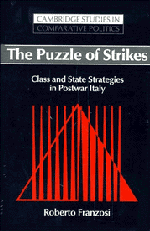Book contents
- Frontmatter
- Contents
- List of tables, figures, and equations
- Dedication
- Preface
- Acknowledgments
- 1 The puzzle box
- 2 Labor-market conditions and bargaining power
- 3 When do workers strike? How the economy matters
- 4 Organizational resources and collective action
- 5 The structure of collective bargaining
- 6 Class power, politics, and conflict
- 7 Mobilization processes: the 1969 autunno caldo
- 8 Countermobilization processes: reactions by the state and employers to strike waves
- 9 The picture in the puzzle
- Epilogue
- Appendix: the data
- Notes
- Bibliography
- Index
5 - The structure of collective bargaining
Published online by Cambridge University Press: 08 January 2010
- Frontmatter
- Contents
- List of tables, figures, and equations
- Dedication
- Preface
- Acknowledgments
- 1 The puzzle box
- 2 Labor-market conditions and bargaining power
- 3 When do workers strike? How the economy matters
- 4 Organizational resources and collective action
- 5 The structure of collective bargaining
- 6 Class power, politics, and conflict
- 7 Mobilization processes: the 1969 autunno caldo
- 8 Countermobilization processes: reactions by the state and employers to strike waves
- 9 The picture in the puzzle
- Epilogue
- Appendix: the data
- Notes
- Bibliography
- Index
Summary
Collective bargaining is the great social invention that has institutionalized industrial conflict. In much the same way as the electoral process and majority rule have institutionalized political conflict in a democracy, collective bargaining has created a stable means for resolving industrial conflict.
Dubin (1954, p. 47)Collective bargaining provides one of the more important bulwarks for the preservation of the private-enterprise system. … Collective bargaining is an institution which bolsters the existing economic order.… A union movement which emphasizes collective bargaining is inevitably a conservative movement, for collective bargaining is inseparable from private enterprise.
Harbison (1954, pp. 274, 277, 278)UNANSWERED QUESTIONS
In Chapters 2 and 3 we saw that economic models of strikes can explain the nonperiodic, medium-term fluctuations in strike activity. In Italy, however, strike activity also shows distinct periodic, two- to three-year cycles. Furthermore, the cycles in numbers of strikes and strikers peak at different times: the cycle in the number of strikers peaks approximately one year earlier than the cycle in the number of strikes.
The evidence confirming the existence of a three-year periodic cycle has been accumulating over the preceding three chapters. The exploratory data analyses summarized in Chapter 1 revealed the basic pattern (Franzosi, 1980). The empirical testing of the Ashenfelter and Johnson model in Chapter 2 showed the existence of a three-year lag structure in real wages, thus pointing to a relationship between a three-year strike cycle and a three-year wage cycle. Traces of this pattern remained unexplained in the residuals obtained from the econometric estimates of the Ashenfelter and Johnson model.
- Type
- Chapter
- Information
- The Puzzle of StrikesClass and State Strategies in Postwar Italy, pp. 143 - 189Publisher: Cambridge University PressPrint publication year: 1995



